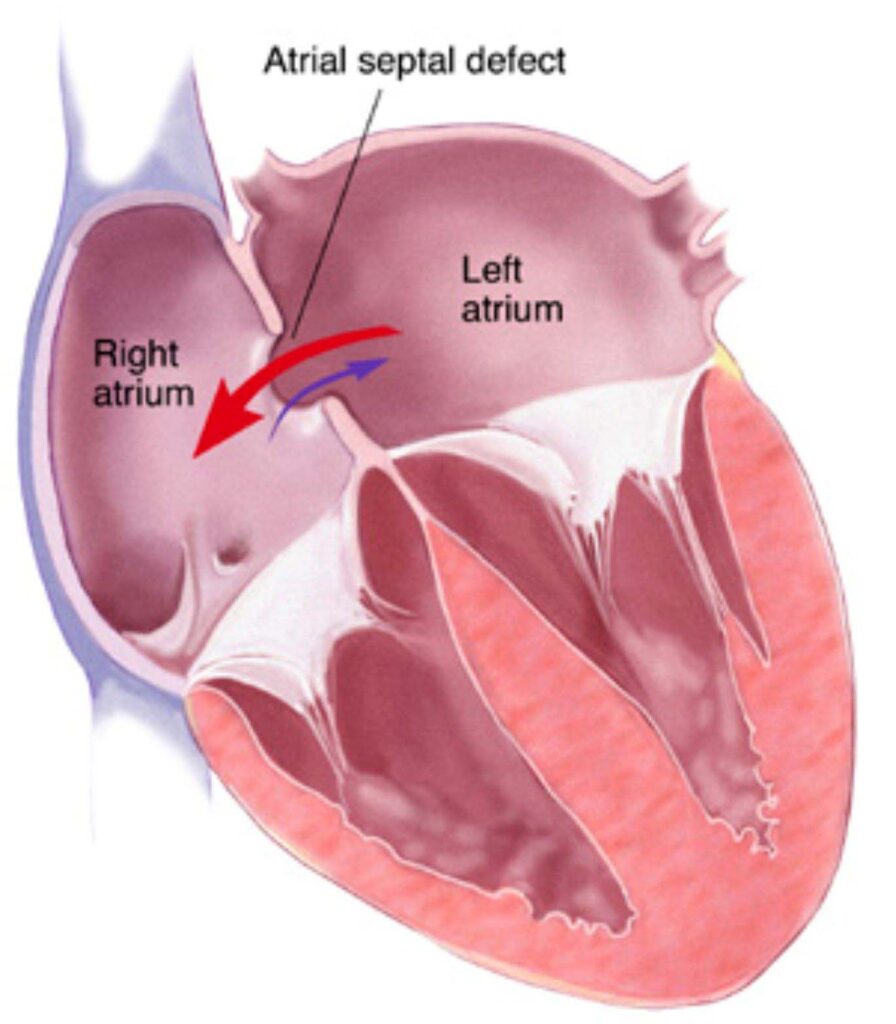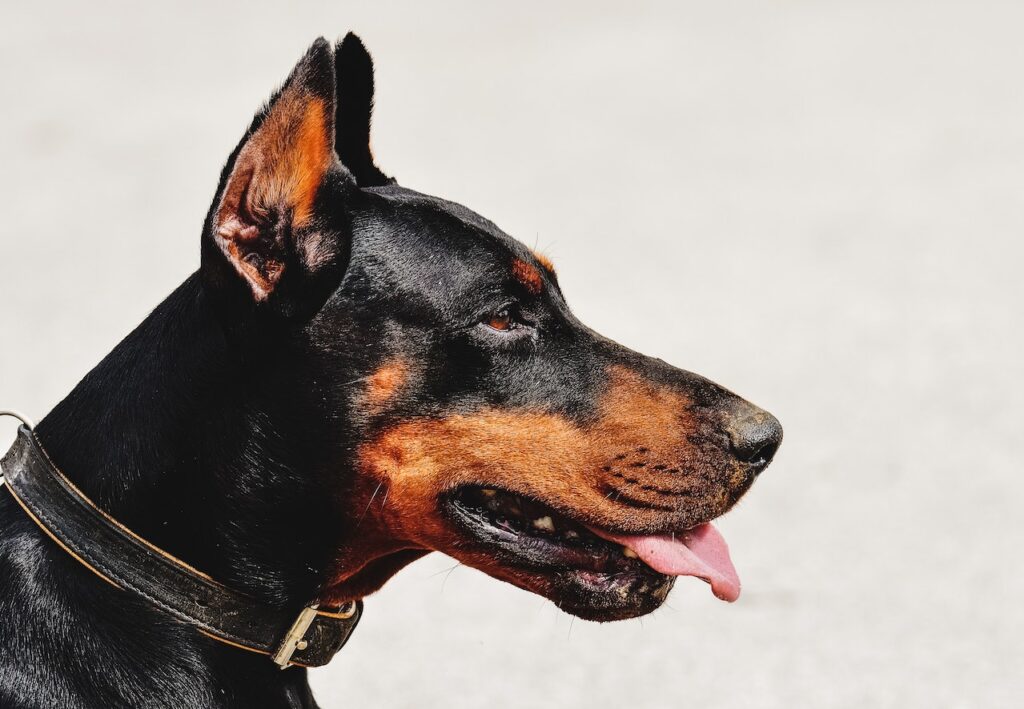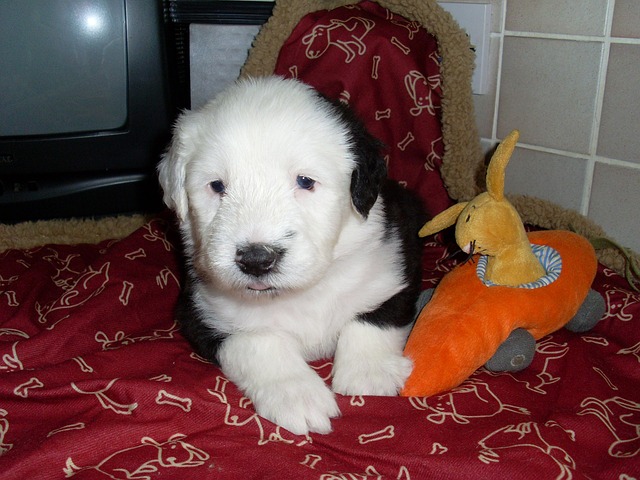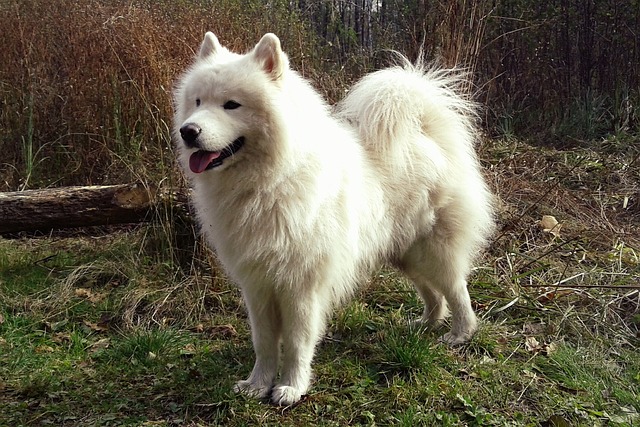Canine Atrial Septal Defect
& Breeds at Risk
Research, Resources & Education
This website is based on research and is NOT created to diagnose your pet.
Each animal is an individual and may exhibit symptoms in a different way.
It is advised that you ALWAYS CHECK WITH YOUR VETERINARIAN for a proper diagnosis and treatment plan.
Table of Contents
Atrial Septal Defect
Atrial septal defect (ASD) is a congenital heart anomaly that enables blood flow between the left and right atria via the interatrial septum (the separating wall).
Symptoms include Exercise intolerance, Fainting/loss of consciousness (syncope), Trouble breathing (dyspnea), Coughing, Heart murmur, Bluish skin (cyanosis), Fluid buildup in the abdomen (ascites)
Treatments include Medication for mild symptoms and possible surgery for severe life-threatening conditions.

What Dogs are at Risk?
Some Dogs that are at Risk due to Genetic Predisposition





What is Atrial Septal Defect ?
Atrial Septal Defect in Dogs (PetMD)
Atrial Septal Defect in Dogs – PetMD
Atrial septal defect (ASD) is a congenital heart anomaly that enables blood flow between the left and right atria via the interatrial septum (the separating wall).
- Typically, the blood will shunt into the right atrium, causing a volume overload to the right atrium, right ventricle, and pulmonary vasculature, which can sometimes lead to pulmonary hypertension.
- However, if right-sided pressures are too high, shunting may occur right to left, causing generalized cyanosis.
- ASD is more common in cats (9 percent of congenital heart defects) than dogs (0.7 percent), though a recent study from France suggests a higher incidence, with ASD accounting for 37.7 percent of congenital cardiac defects in pooled data from dogs and cats.
Atrial Septal Defect (ASD) (Merck Manual)
Atrial septal defect (ASD) – Merck Manual
Atrial septal defect (ASD) is an uncommon congenital heart defect caused by malformation of the interatrial septum, typically resulting in left-to-right shunting across the defect.
- The most common location is the septum secundum (secundum ASD).
- ASD is commonly diagnosed incidentally during echocardiography for concurrent heart disease.
- Large ASD with significant shunting may lead to right heart overload, right heart failure, and acquired pulmonary hypertension.
- Some types of ASD can be closed either surgically or by interventional occlusion.
Atrial Septal Defect Videos
YouTube Videos that help explain Atrial Septal Defect in Dogs
Disclaimer:
This is for research only and Lost Temple Pets does not endorse any video presented on this website.
It is advised that you ALWAYS CHECK WITH YOUR VETERINARIAN for a proper diagnosis and treatment plan.
Types
Three Types (Wag!)
Types (Wag)
There are three different types of ASD depending on where the defect is located.
- Ostium secundum – the hole occurs in the central part of the atrial septum; this is the most common type in dogs and humans
- Sinus venomous defect – the defect occurs in the top part of the atrial septum
- Ostium primum (sometimes called a partial atrioventricular septal defect) – the defect occurs at the bottom of the atrial septum close to the ventricle chambers
- ASD can also occur in combination with other heart defects.
Causes
Causes (Wag)
Causes (Wag)
- ASD is an inherited condition that is thought to be the result of multiple genetic factors.
- ASD is more common in Boxers and Samoyeds
- Canine parents with ASD often pass it on to their children.
Symptoms
Symptoms and Types (PetMD)
Symptoms and Types (PetMD)
ASD occurs in one of three locations: lower atrial septum (ostium primum defect, which is the most common), near the fossa ovalis (ostium secundum defect), or craniodorsal to the fossa ovalis (sinus venous defect).
Common signs associated with ASD include:
- Exercise intolerance
- Fainting/loss of consciousness (syncope)
- Trouble breathing (dyspnea)
- Coughing
- Heart murmur
- Bluish skin (cyanosis)
- Fluid buildup in the abdomen (ascites) if right-sided heart failure develops
Diagnosis and Testing
Diagnosis (PetMD)
Diagnosis – PetMD
You will need to give a thorough history of your dog’s health, including the onset and nature of the symptoms, to the veterinarian. He or she will then perform a complete physical examination as well as a biochemistry profile, urinalysis, complete blood count, and electrolyte panel.
- X-rays and electrocardiograms will typically show right-sided heart and lung vessel enlargement in patients with large defects, while an echocardiogram may reveal right atrial and right ventricular dilation and the actual hole (a septal dropout).
- Arrhythmias and intraventricular conduction disturbances may also be visible using these diagnostic procedures.
- To document the blood flow through the hole and high ejection velocity through the pulmonary artery, doppler echocardiography is useful.
Diagnostic Evaluation (Improve Veterinary Practice)
Diagnostic evaluation – Improve Veterinary Practice
Thoracic radiographs might show right-sided cardiac enlargement, but the most reliable diagnostic tool is echocardiography.
- Echocardiography shows an anechoic portion of the atrial septum through which color Doppler might demonstrate blood flow
- The location of the defect depends on the type of ASD.
- Ostium secundum ASD is the most common and is localized in the dorsal region of the septum. Flows across the defect are often laminar (not turbulent; normal velocities).
- Often, an artefactual echo dropout at the level of the atrial septum can mimic an ASD in two-dimensional echocardiography.
- A patent foramen ovale can also result in blood shunting; however, a membrane is usually visible (no anechoic region).
- A bubble study can show if there is right-to-left shunting with direct visualization of bubbles going from the right to the left atrium.
Treatment
Treatment (Wag)
Treatment – Wag
- Veterinarians don’t usually recommend treatment for dogs that aren’t showing symptoms.
- Although surgery is routine in humans with ASD, in dogs it is more risky and rarely done with conditions that aren’t life threatening. The veterinarian may suggest frequent check-ups to evaluate if the problem is getting worse.
- Dogs with mild symptoms will be given medication to support heart function and reduce congestive heart failure.
- A sodium restricted diet can help to reduce fluid buildup and limited exercise may also be recommended.
- Surgery is an option for severe life-threatening conditions.
- It is more effective in dogs that haven’t developed congestive heart failure yet. Your dog will likely be referred to a specialist.
- Successful surgery has been performed for all types of ASD in dogs, but there is a risk of fatal complications. The specialist will discuss the chances of success before surgery.
- An extensive recovery period will be necessary after the operation.
Medical or Surgical Therapy (Improve Veterinary Practice)
Medical or surgical therapy – Improve Veterinary Practice
Unless there are signs of right-sided CHF, medical therapy is not required.
- Surgical occlusion of the defect can be considered, especially if the defect is large and causes clinical signs.
- This can be done with a minimally invasive approach using devices such as an Amplatzer atrial septal occluder (Gordon et al., 2009)
References
References
Improve Veterinary Practice – Congenital cardiac defects in dogs: pulmonic stenosis and atrial septal defects
By Mattia Basili
29 April 2024
Merck Veterinary Manual (Professional Version) – Atrial Septal Defects in Animals
By Sandra P. Tou, DVM, DACVIM-Cardiology, DACVIM-SAIM
Reviewed/Revised Jan 2020
PetMD – Congenital Heart Defect (Atrial Septal Defect) in Dogs
By PetMD Editorial
Published May 19, 2010
https://www.petmd.com/dog/conditions/cardiovascular/c_dg_atrial_septal_defect
Wag! – Congenital Heart Defect (Atrial Septal Defect) in Dogs
Retrieved 11/15/24
https://wagwalking.com/condition/congenital-heart-defect-atrial-septal-defect
Cardiac/Breed Chart
| BREED | Atrial septal defect (ASD) | Chronic mitral valvular disease (CMVDz) | Dilated cardiomyopathy (DCM) | Mitral valvular dysplasia (MVD) | Patent ductus arteriosus (PDA) | Pulmonic stenosis (PS) | Subaortic stenosis (SAS) | Tricuspid valvular dysplasia (TVD) | |
|---|---|---|---|---|---|---|---|---|---|
| Affenpinscher | Patent ductus arteriosus (PDA) | ||||||||
| Afghan Hound | Dilated cardiomyopathy (DCM) | Mitral valvular dysplasia (MVD) | |||||||
| Airedale Terrier | |||||||||
| Akita (American) | |||||||||
| Alaskan Malamute | |||||||||
| American Eskimo, Toy and Standard | |||||||||
| American Foxhound | |||||||||
| American Pitt Bull Terrier | |||||||||
| American Staffordshire Terrier | |||||||||
| American Water Spaniel | |||||||||
| Anatolian Shepherd Dog | |||||||||
| Australian Cattle Dog | |||||||||
| Australian Shepherd | |||||||||
| Australian Terrier | |||||||||
| Basenji | |||||||||
| Basset Hound | Pulmonic stenosis (PS) | ||||||||
| Beagle | Pulmonic stenosis (PS) | ||||||||
| Bearded Collie | |||||||||
| Beauceron | |||||||||
| Bedlington Terrier | |||||||||
| Belgian Groenendael | |||||||||
| Belgian Malinois | |||||||||
| Belgian Tervuren | |||||||||
| Bernese Mountain Dog | |||||||||
| Bichon Frise’ | Patent ductus arteriosus (PDA) | ||||||||
| Black and Tan Coonhound | |||||||||
| Black Russian Terrier | |||||||||
| Bloodhound | |||||||||
| Boerboel | |||||||||
| Border Collie | |||||||||
| Border Terrier | |||||||||
| Borzoi | |||||||||
| Boston Terrier | Pulmonic stenosis (PS) | ||||||||
| Bouvier des Flandres | Subaortic stenosis (SAS) | ||||||||
| Boxer | Atrial septal defect (ASD) | Dilated cardiomyopathy (DCM) | Pulmonic stenosis (PS) | Subaortic stenosis (SAS) | |||||
| Briard | |||||||||
| Brittany | |||||||||
| Brussels Griffon | |||||||||
| Bull Terrier | Mitral valvular dysplasia (MVD) | ||||||||
| Bull Terrier, Miniature | |||||||||
| Bulldog, English | Pulmonic stenosis (PS) | Subaortic stenosis (SAS) | |||||||
| Bullmastiff | |||||||||
| Cairn Terrier | |||||||||
| Canaan Dog | |||||||||
| Cane Corso (Italian Mastiff) | |||||||||
| Caucasian Shepherd | |||||||||
| Cavalier King Charles Spaniel | Chronic mitral valvular disease (CMVDz) | Patent ductus arteriosus (PDA) | |||||||
| Chesapeake Bay Retriever | |||||||||
| Chihuahua | Chronic mitral valvular disease (CMVDz) | Patent ductus arteriosus (PDA) | Pulmonic stenosis (PS) | ||||||
| Chinese Crested | |||||||||
| Chinese Shar-Pei | |||||||||
| Chow Chow | Pulmonic stenosis (PS) | ||||||||
| Clumber Spaniel | |||||||||
| Cocker Spaniel (American) | Chronic mitral valvular disease (CMVDz) | Dilated cardiomyopathy (DCM) | Patent ductus arteriosus (PDA) | Pulmonic stenosis (PS) | |||||
| Collie, Rough / Smooth Coat | Patent ductus arteriosus (PDA) | ||||||||
| Curly Coated Retriever | |||||||||
| Dachshund | Chronic mitral valvular disease (CMVDz) | ||||||||
| Dalmation | |||||||||
| Dandie Dinmont Terrier | |||||||||
| Doberman Pinscher | Atrial septal defect (ASD) | Dilated cardiomyopathy (DCM) | |||||||
| Dogo Argentino | |||||||||
| Dogue de Bordeaux (Mastiff) | |||||||||
| English Cocker Spaniel | Dilated cardiomyopathy (DCM) | Pulmonic stenosis (PS) | |||||||
| English Foxhound | |||||||||
| English Setter | |||||||||
| English Springer Spaniel | Dilated cardiomyopathy (DCM) | Patent ductus arteriosus (PDA) | |||||||
| English Toy Spaniel AKA King Charles Spaniel | |||||||||
| Field Spaniel | |||||||||
| Finnish Spitz | |||||||||
| Flat-Coated Retriever | |||||||||
| Fox Terrier, Smooth | |||||||||
| Fox Terrier, Toy | |||||||||
| Fox Terrier, Wire | Pulmonic stenosis (PS) | ||||||||
| French Bulldog | |||||||||
| German Pinscher | |||||||||
| German Shepherd | Dilated cardiomyopathy (DCM) | Mitral valvular dysplasia (MVD) | Patent ductus arteriosus (PDA) | Subaortic stenosis (SAS) | Tricuspid valvular dysplasia (TVD) | ||||
| German Shorthaired Pointer | Subaortic stenosis (SAS) | ||||||||
| German Wirehaired Pointer | |||||||||
| Glen of Imaal Terrier | |||||||||
| Golden Retriever | Dilated cardiomyopathy (DCM) | Subaortic stenosis (SAS) | |||||||
| Gordon Setter | |||||||||
| Great Dane | Dilated cardiomyopathy (DCM) | Mitral valvular dysplasia (MVD) | Subaortic stenosis (SAS) | Tricuspid valvular dysplasia (TVD) | |||||
| Great Pyrenees | |||||||||
| Greater Swiss Mountain Dog | |||||||||
| Greyhound | |||||||||
| Harrier | |||||||||
| Havanese | |||||||||
| Ibizan Hound | |||||||||
| Irish Setter | Tricuspid valvular dysplasia (TVD) | ||||||||
| Irish Terrier | Patent ductus arteriosus (PDA) | ||||||||
| Irish Water Spaniel | |||||||||
| Irish Wolfhound | Dilated cardiomyopathy (DCM) | ||||||||
| Italian Greyhound | |||||||||
| Japanese Chin | |||||||||
| Keeshond | Patent ductus arteriosus (PDA) | Pulmonic stenosis (PS) | |||||||
| Kerry Blue Terrier | Patent ductus arteriosus (PDA) | ||||||||
| Komondor | |||||||||
| Kuvasz | |||||||||
| Labrador Retriever | Dilated cardiomyopathy (DCM) | Patent ductus arteriosus (PDA) | Pulmonic stenosis (PS) | Tricuspid valvular dysplasia (TVD) | |||||
| Lakeland Terrier | |||||||||
| Lhasa Apso | Chronic mitral valvular disease (CMVDz) | ||||||||
| Lowchen | |||||||||
| Maltese | Chronic mitral valvular disease (CMVDz) | Patent ductus arteriosus (PDA) | |||||||
| Manchester Terrier Toy | |||||||||
| Manchester Terrier, Standard | |||||||||
| Mastiff, English | Dilated cardiomyopathy (DCM) | Pulmonic stenosis (PS) | |||||||
| Miniature Pincher | |||||||||
| Neapolitan Mastiff | |||||||||
| Newfoundland | Dilated cardiomyopathy (DCM) | Patent ductus arteriosus (PDA) | Pulmonic stenosis (PS) | Subaortic stenosis (SAS) | |||||
| Norfolk Terrier | |||||||||
| Norwegian Buhund | |||||||||
| Norwegian Elkhound | |||||||||
| Norwich Terrier | |||||||||
| Nova Scotia Duck Tolling Retriever | |||||||||
| Old English Sheepdog | Atrial septal defect (ASD) | Dilated cardiomyopathy (DCM) | Tricuspid valvular dysplasia (TVD) | ||||||
| Otterhound | |||||||||
| Papillon | Chronic mitral valvular disease (CMVDz) | ||||||||
| Parsons Russell Terrier | |||||||||
| Pekingese | Chronic mitral valvular disease (CMVDz) | ||||||||
| Petit Basset Griffon Vendeen (PBGV) | |||||||||
| Pharaoh Hound | |||||||||
| Plott Hound | |||||||||
| Pointer | Subaortic stenosis (SAS) | ||||||||
| Polish Lowland Sheepdog | |||||||||
| Pomeranian | Chronic mitral valvular disease (CMVDz) | Patent ductus arteriosus (PDA) | |||||||
| Poodle, Miniature | Chronic mitral valvular disease (CMVDz) | Patent ductus arteriosus (PDA) | |||||||
| Poodle, Standard | Atrial septal defect (ASD) | Patent ductus arteriosus (PDA) | |||||||
| Poodle, Toy | Chronic mitral valvular disease (CMVDz) | Patent ductus arteriosus (PDA) | |||||||
| Portuguese Water Dog | Dilated cardiomyopathy (DCM) | ||||||||
| Presa Canario | |||||||||
| Pug | |||||||||
| Puli | |||||||||
| Pyrenean Shepherd | |||||||||
| Rhodesian Ridgeback | |||||||||
| Rottweiler | Subaortic stenosis (SAS) | ||||||||
| Saluki | |||||||||
| Samoyed | Atrial septal defect (ASD) | Pulmonic stenosis (PS) | Subaortic stenosis (SAS) | ||||||
| Schipperke | |||||||||
| Schnauzer, Miniature | Chronic mitral valvular disease (CMVDz) | Pulmonic stenosis (PS) | |||||||
| Schnauzer, Giant | Pulmonic stenosis (PS) | ||||||||
| Schnauzer, Standard | |||||||||
| Scottish Deerhound | Dilated cardiomyopathy (DCM) | ||||||||
| Scottish Terrier | |||||||||
| Sealyham Terrier | |||||||||
| Shetland Sheepdog | Patent ductus arteriosus (PDA) | ||||||||
| Shiba Inu | |||||||||
| Shih Tzu | Chronic mitral valvular disease (CMVDz) | ||||||||
| Siberian Husky | |||||||||
| Silky Terrier | |||||||||
| Skye Terrier | |||||||||
| Soft-Coated Wheaten Terrier | |||||||||
| Spinone Italiano | |||||||||
| St. Bernard | Dilated cardiomyopathy (DCM) | ||||||||
| Staffordshire Bull Terrier | |||||||||
| Sussex Spaniel | |||||||||
| Swedish Vallhund | |||||||||
| Tibetan Mastiff | |||||||||
| Tibetan Spaniel | |||||||||
| Tibetan Terrier | |||||||||
| Tosa | |||||||||
| Vizsla | |||||||||
| Weimaraner | |||||||||
| Welsh Corgi, Cardigan | Patent ductus arteriosus (PDA) | ||||||||
| Welsh Corgi, Pembroke | Patent ductus arteriosus (PDA) | ||||||||
| Welsh Springer Spaniel | |||||||||
| Welsh Terrier | |||||||||
| West Highland White Terrier | Chronic mitral valvular disease (CMVDz) | Pulmonic stenosis (PS) | |||||||
| Whippet | |||||||||
| Wirehaired Pointing Griffon | |||||||||
| Yorkshire Terrier | Chronic mitral valvular disease (CMVDz) | Patent ductus arteriosus (PDA) | |||||||
| Spanish Mastiff | |||||||||
| Treeing Walker Coonhound | |||||||||
| Barbet | |||||||||
| Cirneco dell'Etna | |||||||||
| Broholmer | |||||||||
| Leonberger | |||||||||
| Rat Terrier | |||||||||
| Xoloitzcuintli | |||||||||
| Dutch Shepherd |